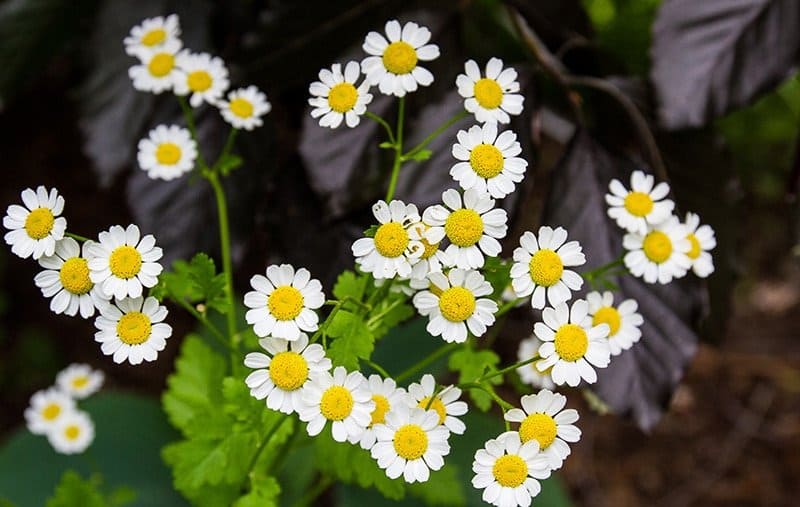
A welcome visitor recently showed up in the front garden. Two patches of feverfew (Tanacetum parthenium) appeared at the foot of a ‘Riversii’ beech (Fagus sylvatica [Atropurpurea Group] ‘Riversii’, Zone 5), and another patch at the foot of a river birch (Betula nigra, Zone 4). The patch under the river birch has been beaten down by heavy rain and probably should be removed. But the clumps under the ‘Riversii’ beech have been protected by low branches and hold their pristine white daisy flowers against the almost black foliage — truly a match made in heaven!
Feverfew is an ornamental herb with honey-scented leaves, long recognized for its medicinal value. Its ferny foliage and charming white daisy flowers held on 24-inch (60-cm) stems have caught the attention of plant breeders, and I’ve found references to at least 16 named cultivars of the species. Some have double flower heads, and others are entirely yellow or have pompom-like forms.
Feverfew is a short-lived perennial, hardy to Zone 6 (and possibly to Zone 5), but it’s usually grown as an annual. In my Zone 6a garden, purchased feverfew plants sometimes survive winter, but I can’t count on them to be there the following spring.
Feverfew is a swift-footed plant, meaning it will seed about and pop up unexpectedly. My experience is that seedlings don’t appear around the mother plant, but instead, are found a distance off. Seed might be moved by wind or animals; deadheading the spent flowers before they go to seed will prevent chance seedlings. But the feverfew that has shown up this summer is a tall variety I never purchased, so I presume it has fortuitously blown in from a neighbour.
I have a dwarf golden feverfew (T. parthenicum ‘Aureum’) in the back garden, a descendant of a purchased plant, and its soft golden leaves are beautiful all summer. Golden feverfew grows about 18 inches (45 cm) tall and keeps its beautiful white daisies shining brightly for about six weeks. Even when the flowers are gone, the gold leaves are lovely alongside perennial geraniums and clumps of lady’s mantle (Alchemilla mollis).
The backdrop of ‘Riversii’ beech is an amazingly good foil for these bright feverfew daisies. It’s the darkest of all red-black beech, opening glossy charcoal-black leaves in spring, melding to maroon black in June, and holding the colour until late summer. This accidental pairing reminds me to buy more feverfew this season to ensure it continues to drift around and bring more happy surprises next summer.









Hi Aldona:
Yes, it’s amazing that gravel can be such a fertile seed bed. I’ve had violas, snapdragons, love-in-a-mist, and even Japanese maple seedlings all appear in gravel patches. And this season must certainly favour feverfew.
– Judith
Feverfew seeds itself around my gravel driveway, along with myriad other plants (most prominently Shasta daisies, snapdragons, aquilegia and especially, cosmos. This year the feverfew has gone absolutely mad, and I have baby plants cropping up everywhere. Perhaps they like all the rain? At least they’re crowding out some of the weeds….